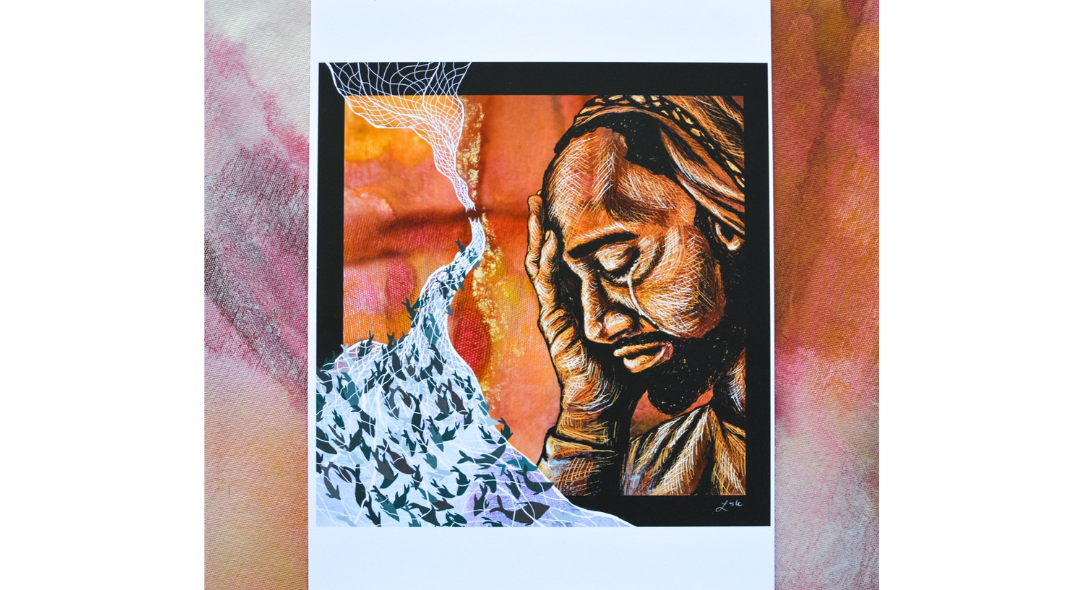Faith & Giving
I'm excited to share updates on the Executive Certificate in Religious Fundraising course and invite you to join our FBCH community in making a meaningful impact through generosity.
Read More

If attending church in person throughout lent you will notice the Stations of Peter art exhibit in the North Transept. We will also be displaying art on the front of our worship guides each week with the accompanying artist statement posted online. These images were printed with permission from A Sanctified Art.
We encourage you to take time to reflect on these images and practice Visio Divina, latin for “divine seeing,” a method of meditation, reflection, and prayer through a process of intentional seeing.
Were You There? by Lisle Gwynn Garrity
(Inspired by John 19:1-30)
Acrylic painting on canvas with digital drawing
Were you there when they crucified my Lord?
This refrain from a well-known Gospel song dances in circles in my mind as I wonder where Peter is when Jesus is crucified. We know that Peter follows Jesus into the courtyard of the High Priest. We know he warms himself by the fire when, again and again, he denies being one of Jesus’ disciples. Then Jesus is dragged away—to be tried, sentenced to death, and finally, killed. But where is Peter?
Since we have to fill in the gaps of the story with our imaginations, this image functions like visual Midrash¹ of Peter’s experience when Jesus dies. I imagine Peter is frozen—with guilt, rage, and regret—still standing by the fire. I imagine he remains there for hours, unable to move, paralyzed by fear. I imagine he mourns privately, pleading for a miracle, praying the worst will not come, crying out again, “God forbid it!” (Matthew 16:22) In the background, the shadow of a cross flickers like flames rising from the charcoal fire.
Whenever I try to make sense of Peter’s actions, I have often thought of attachment theory. Attachment theory, pioneered by British psychologist John Bowlby, explores how a child’s relationship with their caregivers early in life determines how they navigate secure (or insecure) emotional bonds into adulthood. There are four primary attachment styles: anxious (driven by the fear of rejection and abandonment), avoidant (driven by the fear of vulnerability and intimacy), disorganized (exhibiting inconsistent and unpredictable behavior led by distrust), and secure (signified by good self-esteem and seeking support from others). I wonder if Peter shows us the full spectrum of attachment styles throughout his journey. Again and again, Jesus invites him into secure attachment—through catching him when he sinks, offering him food and forgiveness, washing his feet. And yet, Peter often responds with behaviors that might define anxious, avoidant, or disorganized attachment styles: he resists, he pulls away, he draws his sword, he denies knowing Jesus.
Were you there when they crucified my Lord?
For Peter, the answer is “no.” He has left the God he loves. However, the good news about attachment theory is that even if you have an anxious, avoidant, or disorganized attachment style, you can gradually— through healthy relationships, vulnerability, and interdependence—find secure attachment.
In this image, God’s river of grace flows out from the cross and spills out before a bereaved Peter. Even in this moment of deep despair, God’s abundance rushes to greet him. Peter’s nets may feel as empty as the day Jesus crawled into his boat (Luke 5:5a), but we know that an abundant feast—around another charcoal fire—shall soon come (John 21:9-14).
—Rev. Lisle Gwynn Garrity
1 Midrash, as a method of interpretation, focuses on what is said and unsaid in a text, using imagination to derive additional narratives to stand alongside the scripture as it is recorded.